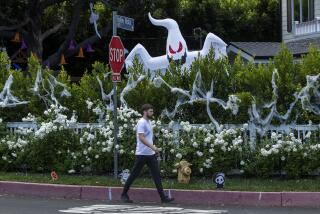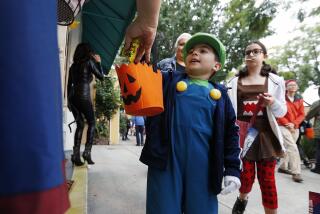Scary, But Safe
- Share via
COSTUMES* Masks should have eye holes large enough so children can see clearly. Better yet, use nontoxic, hypoallergenic makeup or face paint.
* Costumes should be short enough so child won’t trip and be flame resistant. Shoes should fit and have low heels.
* Accessories and props should not be sharp. Fake swords and knives should be made of flexible material. Avoid toy guns that might be mistaken for the real thing.
* Trick-or-treaters should carry flashlights.
* Trim costumes and candy bags with reflective tape to make kids more visible.
WHILE TRICK-OR-TREATING* Go only to houses that have an outside light on to welcome trick-or-treaters.
* Stay on well lighted streets; avoid shortcuts through darkened alleys, parks or backyards.
* Never go into a stranger’s home or accept a ride from a stranger.
* Adults or an older, responsible child should accompany children when they trick-or-treat. Parents should know the exact route children will take and set a precise limit on the time children will be out.
* Walk, don’t run, on your rounds. Stay on the sidewalk. Cross streets at crosswalks; never dart from between parked cars, jaywalk or cross intersections diagonally. Children wearing masks should remove them before crossing so they can see and hear.
AT HOME
* Pumpkins lighted by candles should never be left unattended and should be kept away from anything flammable. Do not place where trick-or-treaters can brush against them.
* Make sure no obstacles or hazards--hoses, bicycles, lawn ornaments--are on the front lawn, steps or porch. Trim overgrown foliage and sweep wet leaves or garden debris.
* Keep pets inside and away from Halloween activities. Sights and sounds cause pets to panic or become aggressive. Candy, especially chocolate, can be harmful to some pets. Keep pets away from decorations. Pets, particularly black cats, can also fall victim to the cruelty of some pranksters.
AFTER TRICK-OR-TREATING
* Check treats for signs of tampering--pinholes,torn or loose wrappers, anything that would suggest the package has been opened. If in doubt, throw it out.
Sources: U.S. Consumer Product Safety Commission, Temple University, Humane Society of the United States, police departments.
Graphic and reporting by PAUL DUGINSKI / Los Angeles Times






